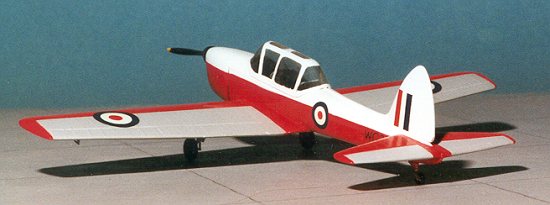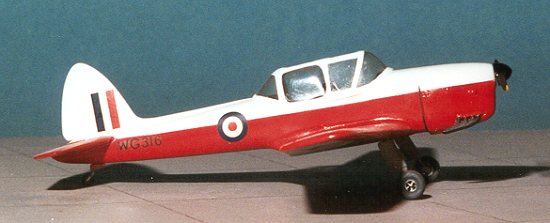
Aeroclub 1/48 DHC-1 Chipmunk
| KIT # | |
| PRICE: | $15.00, in the mid-1980s |
| DECALS: | One aircraft |
| REVIEW : | |
| NOTES: | Kit vacuform with white metal |

| HISTORY |
 The Chipmunk was the first complete design for DeHavilland
of Canada. Ithad to be of modern construction, easy to fly, fully aerobatic, and without
vices. The aircraft was designed by W.Jakimiuk who also designed the advanced PZL P.50monoplane fighter of 1939.
The Chipmunk was the first complete design for DeHavilland
of Canada. Ithad to be of modern construction, easy to fly, fully aerobatic, and without
vices. The aircraft was designed by W.Jakimiuk who also designed the advanced PZL P.50monoplane fighter of 1939.
157 were produced in Canada from 1946 to 1952, with delivery to the RCAF and a number of other air forces and flying schools. In 1955, an additional 60 were produced, these having larger one-piece clear view canopies.
Production lines for the Chipmunk were set up in the UK where an additional 1,000 were produced, most of them for various British armed forces, though many were exported, the last being to Saudi Arabia in 1956.
In addition to the UK, there was a production line opened byOGMA in Portugal where a number were produced for that country. The Chipmunk was finally retired from RAF service in the 1990s. Many are still flying in the hands of civilian operators and a few armed forces even today.
| THE KIT |
This kit was one of Aeroclub's first forays into what we now call a multi-media
kit. While the majority of it was on a single vacuformed sheet, there was a
small bag containing some metal parts and there was a decal sheet. The decal
sheet is for a generic Chipmunk and like many  decals of the time seems to havebeen made pre-yellowed! The metal bits were the wheels, landing gear
legs, propeller, exhaust, tail wheel and pitot tube.
decals of the time seems to havebeen made pre-yellowed! The metal bits were the wheels, landing gear
legs, propeller, exhaust, tail wheel and pitot tube.
The instructions were typical of almost all vacuform kits of the day in that there was an exploded view of the kit and some color information. That was about it. It took me almost two years from the time I got the kit until I actually started building it. Not a bad wait when you consider that it took well over 10years for me to get around to the other Aeroclub kit I bought about the same time!
TheDHC-1 was my first multimedia kit and while it seems quite simple today, it wasn't the case back in late 1986 when I started work on the kit. However, the kit really did go together well. It was perfect for an initiation into the genre.
| CONSTRUCTION |
It is fortunate that I can not only remember so much about building the kit, but that I actually took a few notes on it (for the next time I was to build a similar kit). As with all vacuformed kits, the first step is to remove the vac parts from the backing sheet. This is done by first drawing all-around the part with a soft lead pencil Then I scribed around all the parts with a sharp Xacto blade, holding the blade at about a 45 degree angle. When done, I simply flexed the parts and the backing sheet snapped clean. This left me with a pencil line showing where the plastic I don't want to remove is separated from the clean plastic that I DO want to remove.
 Next, I put a
full sheet of 220 grit sandpaper on a piece of Plexiglas and then took it to the
sink to start sanding. By gently running water over the sheet, it not only helps
the sheet stick to the Plexiglas, but also the running water washes away plastic
dust that would otherwise clog the paper. The trick is not to take too
much off. Naturally, I messed up a few bits.
Next, I put a
full sheet of 220 grit sandpaper on a piece of Plexiglas and then took it to the
sink to start sanding. By gently running water over the sheet, it not only helps
the sheet stick to the Plexiglas, but also the running water washes away plastic
dust that would otherwise clog the paper. The trick is not to take too
much off. Naturally, I messed up a few bits.
Once the bits are all sanded down, regular construction can commence. The first part was,of course, the interior. This was made of a form fitted cockpit molding and seats. There was no instrument panel or control sticks. No sidewall detail at all and the other pieces were a bit light on detailing as well. Fortunately, the interior is a nicely molded piece so sticking on the white metal parts wasn't a hassle. What was a hassle was getting the seats properly shaped as they were vacuformed and bit weak on the bottom. Because of the lack of instrument panels and sticks, I painted the interior flat black and the seats aluminum. The interior fit very well into the fuselage halves and the fuselage was then cemented together.
The tail plane installation was next and that went without trauma. It simply slid into the slot at the rear. A slathering of filler for this gap and a few on the fuselage were all that was needed. To add strength to the fuselage, the separate nose cap was then glued on and smoothed out with filler and sandpaper.
To ease construction, the wing was just two pieces, an upper and lower section. After this was glued together, it was then cemented to the underside of the fuselage. Like I said, a perfect beginner's kit. The vacuformed canopy was then cut out and glued onto the fuselage. Then it was masked off with Scotch Tape (a BIG mistake). Now it was onto the paint shop. Installation of the metal bits would wait until after painting.
| PAINT & DECALS |
 Standard
training scheme for Chipmunks was red, white and aircraft grey. The upper
fuselage was white, the aft section of the wings and tailplane were aircraft grey and the rest was red. I started by painting the kit white. Then the
white was masked off and the red was painted on. I used Testors Model Master
paints for these colors. Then the red was masked and the aircraft grey was painted
on. Again, I used a Model Master paint that was close. This was a matte color, but
I was ignorant of the fact that it should have been gloss so let it go. At this
time, the gear legs were also painted aircraft grey. I was going to paint the anti-glare shield black, but for some reason, never got around to it.
Standard
training scheme for Chipmunks was red, white and aircraft grey. The upper
fuselage was white, the aft section of the wings and tailplane were aircraft grey and the rest was red. I started by painting the kit white. Then the
white was masked off and the red was painted on. I used Testors Model Master
paints for these colors. Then the red was masked and the aircraft grey was painted
on. Again, I used a Model Master paint that was close. This was a matte color, but
I was ignorant of the fact that it should have been gloss so let it go. At this
time, the gear legs were also painted aircraft grey. I was going to paint the anti-glare shield black, but for some reason, never got around to it.
Then, for some inexplicable reason, the kit sat for a few months.
When interest returned, I applied the decals. They are fine on a
white background. However, the white in the roundel is a bit transparent. To
make matters worse, for some reason, when a couple of roundels were taken off
the backing sheet, some of the white stayed there!! I used the Microscale system
to apply the decals with no problems. I did not overcoat them as I didn't do such
a thing back then. I also didn't apply a gloss to the aircraft before applying
them. Hey, we all learn, you know!
| CONSTRUCTION CONTINUES |
Now that all the decals were on it, it was time to take off the tape. Man,
was this a real chore! The tape had just about cemented itself to the canopy in
the months it sat. I had to chip the stuff off and did dirty to the canopy in
the process. Not much to do about it now as there was no second canopy in the
box. The prop was painted black with yellow tips (it should be black and white
bands). The exhaust and wheels were glued in as were the tail wheel and the pitot tube. That's it!
| CONCLUSIONS |
Despite the self-generated glitch with the tape, this was really a very nice kit to build. It was perfect for me as I was a bit hesitant about doing such a model. My understanding is that Aeroclub has issued this model
in full styrene. If so, I'd suggest putting the grabs on it as it really is a super kit.| REFERENCES |
Planemakers 3: De Havilland, by Philip J Birtles, 1984
Copyright ModelingMadness.com. All rights reserved.
Review kit courtesy of me and my wallet!
If you would like your product reviewed fairly and fairly quickly, please contact the editor or see other details in the